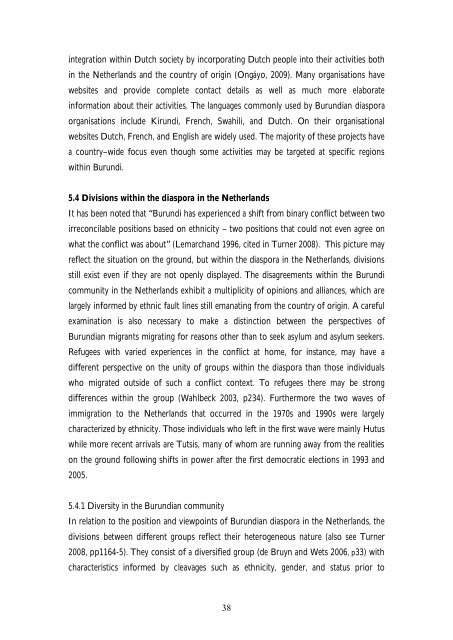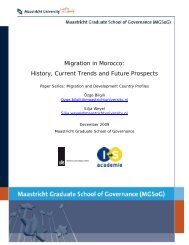Migration in Burundi: History, Current Trends and Future - MGSoG ...
Migration in Burundi: History, Current Trends and Future - MGSoG ...
Migration in Burundi: History, Current Trends and Future - MGSoG ...
You also want an ePaper? Increase the reach of your titles
YUMPU automatically turns print PDFs into web optimized ePapers that Google loves.
<strong>in</strong>tegration with<strong>in</strong> Dutch society by <strong>in</strong>corporat<strong>in</strong>g Dutch people <strong>in</strong>to their activities both<br />
<strong>in</strong> the Netherl<strong>and</strong>s <strong>and</strong> the country of orig<strong>in</strong> (Ongáyo, 2009). Many organisations have<br />
websites <strong>and</strong> provide complete contact details as well as much more elaborate<br />
<strong>in</strong>formation about their activities. The languages commonly used by <strong>Burundi</strong>an diaspora<br />
organisations <strong>in</strong>clude Kirundi, French, Swahili, <strong>and</strong> Dutch. On their organisational<br />
websites Dutch, French, <strong>and</strong> English are widely used. The majority of these projects have<br />
a country–wide focus even though some activities may be targeted at specific regions<br />
with<strong>in</strong> <strong>Burundi</strong>.<br />
5.4 Divisions with<strong>in</strong> the diaspora <strong>in</strong> the Netherl<strong>and</strong>s<br />
It has been noted that “<strong>Burundi</strong> has experienced a shift from b<strong>in</strong>ary conflict between two<br />
irreconcilable positions based on ethnicity – two positions that could not even agree on<br />
what the conflict was about” (Lemarch<strong>and</strong> 1996, cited <strong>in</strong> Turner 2008). This picture may<br />
reflect the situation on the ground, but with<strong>in</strong> the diaspora <strong>in</strong> the Netherl<strong>and</strong>s, divisions<br />
still exist even if they are not openly displayed. The disagreements with<strong>in</strong> the <strong>Burundi</strong><br />
community <strong>in</strong> the Netherl<strong>and</strong>s exhibit a multiplicity of op<strong>in</strong>ions <strong>and</strong> alliances, which are<br />
largely <strong>in</strong>formed by ethnic fault l<strong>in</strong>es still emanat<strong>in</strong>g from the country of orig<strong>in</strong>. A careful<br />
exam<strong>in</strong>ation is also necessary to make a dist<strong>in</strong>ction between the perspectives of<br />
<strong>Burundi</strong>an migrants migrat<strong>in</strong>g for reasons other than to seek asylum <strong>and</strong> asylum seekers.<br />
Refugees with varied experiences <strong>in</strong> the conflict at home, for <strong>in</strong>stance, may have a<br />
different perspective on the unity of groups with<strong>in</strong> the diaspora than those <strong>in</strong>dividuals<br />
who migrated outside of such a conflict context. To refugees there may be strong<br />
differences with<strong>in</strong> the group (Wahlbeck 2003, p234). Furthermore the two waves of<br />
immigration to the Netherl<strong>and</strong>s that occurred <strong>in</strong> the 1970s <strong>and</strong> 1990s were largely<br />
characterized by ethnicity. Those <strong>in</strong>dividuals who left <strong>in</strong> the first wave were ma<strong>in</strong>ly Hutus<br />
while more recent arrivals are Tutsis, many of whom are runn<strong>in</strong>g away from the realities<br />
on the ground follow<strong>in</strong>g shifts <strong>in</strong> power after the first democratic elections <strong>in</strong> 1993 <strong>and</strong><br />
2005.<br />
5.4.1 Diversity <strong>in</strong> the <strong>Burundi</strong>an community<br />
In relation to the position <strong>and</strong> viewpo<strong>in</strong>ts of <strong>Burundi</strong>an diaspora <strong>in</strong> the Netherl<strong>and</strong>s, the<br />
divisions between different groups reflect their heterogeneous nature (also see Turner<br />
2008, pp1164-5). They consist of a diversified group (de Bruyn <strong>and</strong> Wets 2006, p33) with<br />
characteristics <strong>in</strong>formed by cleavages such as ethnicity, gender, <strong>and</strong> status prior to<br />
38



